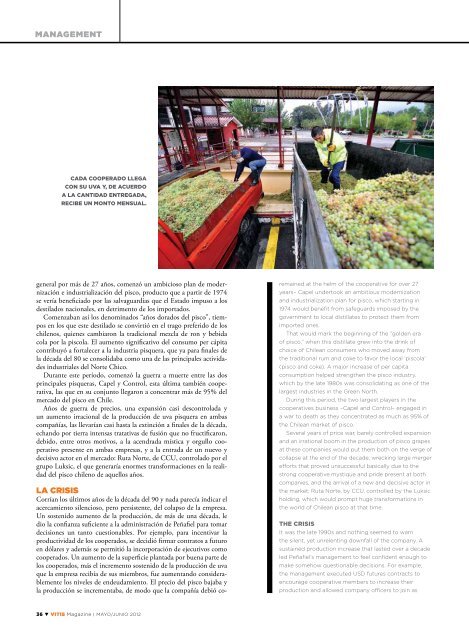Las Lecciones de La crisis y La defensa deL modeLo cooperatiVista
Las Lecciones de La crisis y La defensa deL modeLo cooperatiVista
Las Lecciones de La crisis y La defensa deL modeLo cooperatiVista
Create successful ePaper yourself
Turn your PDF publications into a flip-book with our unique Google optimized e-Paper software.
management<br />
CADA COOPERADO LLEGA<br />
CON Su uVA y, DE ACuERDO<br />
A LA CANTIDAD ENTREGADA,<br />
RECIBE uN mONTO mENSuAL.<br />
general por más <strong>de</strong> 27 años, comenzó un ambicioso plan <strong>de</strong> mo<strong>de</strong>rnización<br />
e industrialización <strong>de</strong>l pisco, producto que a partir <strong>de</strong> 1974<br />
se vería beneficiado por las salvaguardias que el Estado impuso a los<br />
<strong>de</strong>stilados nacionales, en <strong>de</strong>trimento <strong>de</strong> los importados.<br />
Comenzaban así los <strong>de</strong>nominados “años dorados <strong>de</strong>l pisco”, tiempos<br />
en los que este <strong>de</strong>stilado se convirtió en el trago preferido <strong>de</strong> los<br />
chilenos, quienes cambiaron la tradicional mezcla <strong>de</strong> ron y bebida<br />
cola por la piscola. El aumento significativo <strong>de</strong>l consumo per cápita<br />
contribuyó a fortalecer a la industria pisquera, que ya para finales <strong>de</strong><br />
la década <strong>de</strong>l 80 se consolidaba como una <strong>de</strong> las principales activida<strong>de</strong>s<br />
industriales <strong>de</strong>l Norte Chico.<br />
Durante este período, comenzó la guerra a muerte entre las dos<br />
principales pisqueras, Capel y Control, esta última también cooperativa,<br />
las que en su conjunto llegaron a concentrar más <strong>de</strong> 95% <strong>de</strong>l<br />
mercado <strong>de</strong>l pisco en Chile.<br />
Años <strong>de</strong> guerra <strong>de</strong> precios, una expansión casi <strong>de</strong>scontrolada y<br />
un aumento irracional <strong>de</strong> la producción <strong>de</strong> uva pisquera en ambas<br />
compañías, las llevarían casi hasta la extinción a finales <strong>de</strong> la década,<br />
echando por tierra intensas tratativas <strong>de</strong> fusión que no fructificaron,<br />
<strong>de</strong>bido, entre otros motivos, a la acendrada mística y orgullo cooperativo<br />
presente en ambas empresas, y a la entrada <strong>de</strong> un nuevo y<br />
<strong>de</strong>cisivo actor en el mercado: Ruta Norte, <strong>de</strong> CCU, controlado por el<br />
grupo Luksic, el que generaría enormes transformaciones en la realidad<br />
<strong>de</strong>l pisco chileno <strong>de</strong> aquellos años.<br />
<strong>La</strong> <strong>crisis</strong><br />
Corrían los últimos años <strong>de</strong> la década <strong>de</strong>l 90 y nada parecía indicar el<br />
acercamiento silencioso, pero persistente, <strong>de</strong>l colapso <strong>de</strong> la empresa.<br />
Un sostenido aumento <strong>de</strong> la producción, <strong>de</strong> más <strong>de</strong> una década, le<br />
dio la confianza suficiente a la administración <strong>de</strong> Peñafiel para tomar<br />
<strong>de</strong>cisiones un tanto cuestionables. Por ejemplo, para incentivar la<br />
productividad <strong>de</strong> los cooperados, se <strong>de</strong>cidió firmar contratos a futuro<br />
en dólares y a<strong>de</strong>más se permitió la incorporación <strong>de</strong> ejecutivos como<br />
cooperados. Un aumento <strong>de</strong> la superficie plantada por buena parte <strong>de</strong><br />
los cooperados, más el incremento sostenido <strong>de</strong> la producción <strong>de</strong> uva<br />
que la empresa recibía <strong>de</strong> sus miembros, fue aumentando consi<strong>de</strong>rablemente<br />
los niveles <strong>de</strong> en<strong>de</strong>udamiento. El precio <strong>de</strong>l pisco bajaba y<br />
la producción se incrementaba, <strong>de</strong> modo que la compañía <strong>de</strong>bió co-<br />
36 ▼ Vitis Magazine l Mayo/junio 2012<br />
remained at the helm of the cooperative for over 27<br />
years– Capel un<strong>de</strong>rtook an ambitious mo<strong>de</strong>rnization<br />
and industrialization plan for pisco, which starting in<br />
1974 would benefit from safeguards imposed by the<br />
government to local distillates to protect them from<br />
imported ones.<br />
That would mark the beginning of the “gol<strong>de</strong>n era<br />
of pisco,” when this distillate grew into the drink of<br />
choice of Chilean consumers who moved away from<br />
the traditional rum and coke to favor the local ‘piscola’<br />
(pisco and coke). a major increase of per capita<br />
consumption helped strengthen the pisco industry,<br />
which by the late 1980s was consolidating as one of the<br />
largest industries in the Green north.<br />
During this period, the two largest players in the<br />
cooperatives business –Capel and Control– engaged in<br />
a war to <strong>de</strong>ath as they concentrated as much as 95% of<br />
the Chilean market of pisco.<br />
Several years of price war, barely controlled expansion<br />
and an irrational boom in the production of pisco grapes<br />
at these companies would put them both on the verge of<br />
collapse at the end of the <strong>de</strong>ca<strong>de</strong>, wrecking large merger<br />
efforts that proved unsuccessful basically due to the<br />
strong cooperative mystique and pri<strong>de</strong> present at both<br />
companies, and the arrival of a new and <strong>de</strong>cisive actor in<br />
the market: Ruta norte, by CCu, controlled by the Luksic<br />
holding, which would prompt huge transformations in<br />
the world of Chilean pisco at that time.<br />
THE CRISIS<br />
it was the late 1990s and nothing seemed to warn<br />
the silent, yet unrelenting downfall of the company. a<br />
sustained production increase that lasted over a <strong>de</strong>ca<strong>de</strong><br />
led Peñafiel’s management to feel confi<strong>de</strong>nt enough to<br />
make somehow questionable <strong>de</strong>cisions. For example,<br />
the management executed uSD futures contracts to<br />
encourage cooperative members to increase their<br />
production and allowed company officers to join as


